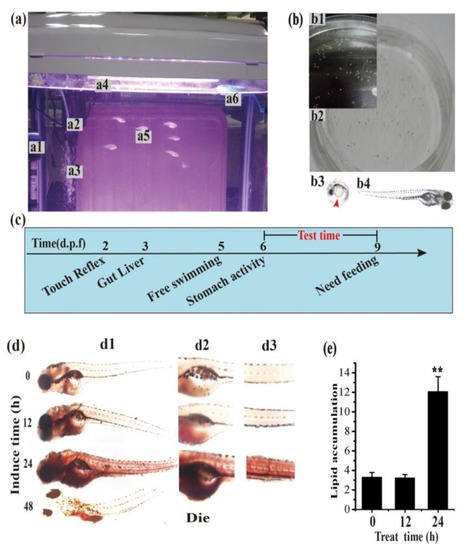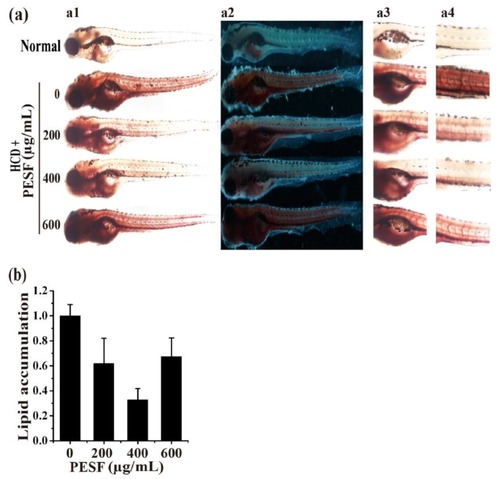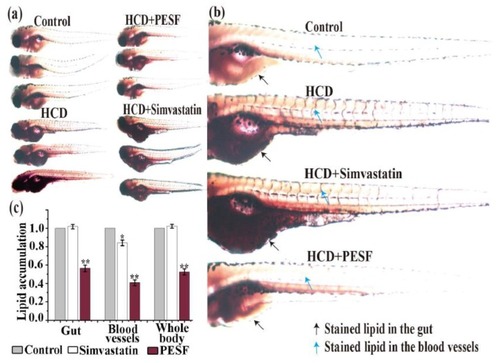- Title
-
Lipid-Lowering Effect of the Pleurotus eryngii (King Oyster Mushroom) Polysaccharide from Solid-State Fermentation on Both Macrophage-Derived Foam Cells and Zebrafish Models
- Authors
- Wei, H., Yue, S., Zhang, S., Lu, L.
- Source
- Full text @ Polymers (Basel)
|
Establishment of the zebrafish larvae hyperlipidemia model. (a) Photographs of zebrafish during breeding. Adult zebrafish (a5) were fed with live brine shrimp twice daily and housed in a light- and temperature-controlled aquaculture facility (a) installed with a thermometer (a1), heating rods (a1), a filter device (a2), an oxygen pump (a3), lamp (a4), and a feeding ring (a6) with a standard 14:10 h light/dark cycle at 28 °C in fish water. Four to five pairs of adult zebrafish were set up for natural mating every time; (b) Representative photographs of zebrafish embryos and larvae. On average, 200–300 embryos (b1) are generated. Embryos and larvae (b2) were maintained at 28 °C in fish water on the open plate in the light of the incubator. Microphotographs showing that the zebrafish embryos (b3) and larvae (b4) are transparent all the way around except for little black scales on the body surface by a dissecting stereo microscope; (c) The developmental introduction of zebrafish larvae. Zebrafish larvae of 6 days post-fertilization (d.p.f.) begin to show stomach activity and can live without food supplementation within 9 d.p.f. Thus, zebrafish larvae at 6 d.p.f. were selected for the experiment model in the next experiment; (d) Representative microphotographs of the whole body (d1), the gut (d2) and the blood vessels (d3) with red stainable lipids induced by the high-cholesterol diet (HCD) at different times (0, 12, 24, 48 h) in the zebrafish larvae hyperlipidemia model by a dissecting stereomicroscope. Stainable lipids in the zebrafish larvae increased uniformly and suddenly with feeding time from 12 to 24 h and caused death at 48 h; (e) Normalized quantification data of stainable red lipid content correlated to microphotographs (d) in the zebrafish hyperlipidemia model.
PHENOTYPE:
|
|
Lipid-lowering effect of PESF in the zebrafish hyperlipidemia model. (a) Representative photographs of zebrafish larval appearance with stainable lipids treated by PESF at different concentrations of 0, 200, 400 and 600 µg/mL respectively, in light (a1) and dark (a2) fields by a dissecting stereomicroscope. Stainable lipids in the zebrafish whole body (a1) (a2), gut (a3) and blood vessels (a4) decreased with PESF at concentrations of 0 to 400 µg/mL, but not 600 µg/mL. (b) Lipid content was normalized to the integral optical density (IOD) data through gut and blood vessel (a1) in the zebrafish larvae hyperlipidemia model.
|
|
Comparison of PESF and simvastatin on inhibition of lipid accumulation in the zebrafish larvae model. (a) Representative photographs of zebrafish larval appearance with stainable lipids treated by PESF and simvastatin in the zebrafish model. Zebrafishes at 6 d.p.f were fed with HCD from 0 h to 24 h uninterruptedly and exposed to PESF (200 µg/mL) and simvastatin (200 µg/mL) from 12 h to 24 h and then stained by ORO at 24 h for image acquisition. For the zebrafishes in the normal group, no HCD was fed during the culture time. Conversely, the HCD group was fed with HCD for 24 h uninterruptedly. (b) Representative photographs of zebrafish larval appearance with stainable red lipids treated by PESF and simvastatin compared with the HCD group and the normal group. Black arrows point to lipids in blood vessels and blue arrows point to lipids in the gut. (c) Normalized quantification data of stainable lipid content in the zebrafish (gut, blood vessels, whole body) treated by PESF and simvastatin, correlated to microphotographs (a1), based on the HCD group set as 100%.
|



